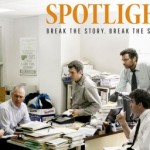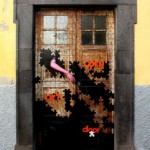 . . . . wise men from the East came to Jerusalem, asking, “Where is the child who has been born king . . . . (Matthew 2: 1-2)
. . . . wise men from the East came to Jerusalem, asking, “Where is the child who has been born king . . . . (Matthew 2: 1-2)
In Matthew’s tale of Jesus’ birth the only company, and the only recognition of the Child, comes from three strangers, called Wise Men, who were foolish enough to trust Herod the King (whom any urchin in the streets of Jerusalem could have warned them was a tricky character) and who were wise enough to read the signs of the times in the heavens, and in prophetic visions of the Ancient Ones in many lands.
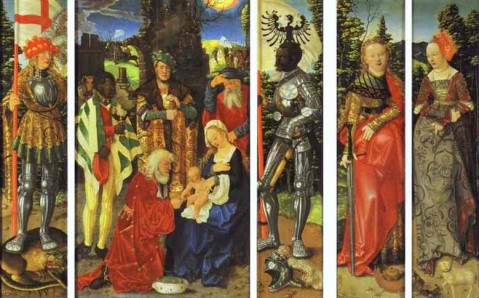 They are fabulous creatures, these Wise Kings, regal and elegant and unafraid of travel by night in faraway places. Followers of light, they do not focus on darkness, but are fixed on the brilliant beams of the day-blind stars, and one star in particular, which leads them to the humble and holy Family. They bear gifts.
They are fabulous creatures, these Wise Kings, regal and elegant and unafraid of travel by night in faraway places. Followers of light, they do not focus on darkness, but are fixed on the brilliant beams of the day-blind stars, and one star in particular, which leads them to the humble and holy Family. They bear gifts.
In legends now read only by children, legends which once were hallowed tales of wisdom, many children set out on dangerous journeys, with huge tasks to accomplish that only very hopeful hearts would undertake: the kind of hearts you can only find in children. And to these children, in the moments just before their journey begins, Someone (godparent, good witch, mysterious beggar, dying king) gives three small and curious things, puzzling things that seem to have no special use (a comb, a mirror, a seashell, a blue stone, a whistle, whatever) and an assurance that, when the time is right, these will be very useful. And sure enough, they are the keys to surviving ominous perils.
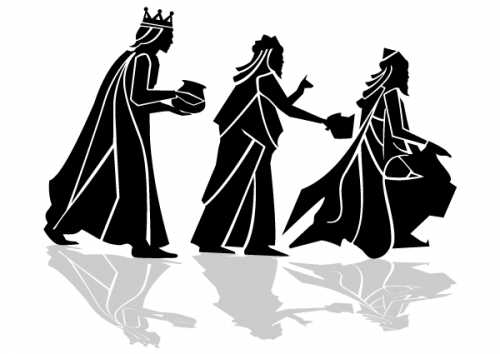 The Wise Men give the Child three gifts: gold; frankincense; and myrrh. Many still are taught that the gold signified the Baby would be a King, and the frankincense and myrrh were for his royal death. But why deliver mysterious symbols to this Child, symbols it would take centuries to decipher? And why undertake such a journey to deliver them?
The Wise Men give the Child three gifts: gold; frankincense; and myrrh. Many still are taught that the gold signified the Baby would be a King, and the frankincense and myrrh were for his royal death. But why deliver mysterious symbols to this Child, symbols it would take centuries to decipher? And why undertake such a journey to deliver them?
Matthew contrasts the Magi’s recognition of the Child, even from afar, to Herod’s dimwitted ignorance of the prophecies, the birth, and then, of its meaning.
Perhaps more important, Matthew shines the light of the Star on birth and death, twin forces in the destiny of this Child, and twin forces in our own lives. Both, in this Child, will glorify God. All, in the life and death of this Child, will glorify God.
The three gifts: gold, frankincense, and myrrh, which are never mentioned again in Matthew’s gospel, will be valuable assets in averting the ominous perils that follow on the heels of the Mages visit, when the soldiers of Herod rush in to slaughter the Innocents, breathlessly close to Fleeing Family.
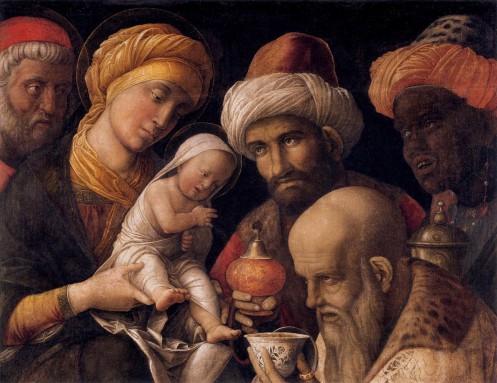 What better than gold for buying safe passage out of Jerusalem? What better than medicinal and funereal herbs, to be exchanged for food at a market on the way to Egypt, or for housing in Egypt, or for clothing to make them more able to blend into the surroundings in which, for two years, they will be refugees?
What better than gold for buying safe passage out of Jerusalem? What better than medicinal and funereal herbs, to be exchanged for food at a market on the way to Egypt, or for housing in Egypt, or for clothing to make them more able to blend into the surroundings in which, for two years, they will be refugees?
Warned by the angel that Herod means harm to the Child, the Magi return home by another way, and are never heard about, or from, again.
T. S. Eliot imagines their ponderings:
. . . . were we led all that way for
Birth or Death? There was a Birth,
certainly,
We had evidence and no doubt.
I had seen birth and death,
But had thought they were different;
this Birth was
Hard and bitter agony for us, like
Death, our death. . . . .
(Excerpt from T.S. Eliot, The Journey of the Magi)
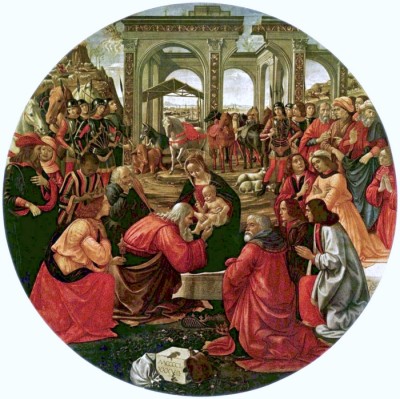 The Child lives unrecognized, according to Matthew, until his baptism. Then the Light falls upon him, and is seen in him by a throng.
The Child lives unrecognized, according to Matthew, until his baptism. Then the Light falls upon him, and is seen in him by a throng.
The tale remains a mystery, remembered most in pageantry, the arrival of Mysterious Strangers. In the tale a larger Wisdom envelops them all, Magi, Caravan, Horrible Herod, Little Family, Christmas Child, Years in Egypt, Years at Home.
It is a wisdom that, like the Three Gifts, escapes our saying but not our knowing. It is a wisdom in which Life and Death together become a Glory that shines brightly, a Star in the Night of all that has fallen into Deep Darkness and been Forgotten, a Light that opens a Great Blessing between what is mortal and what is divine. O Light Divine!
________________________________________________________
Illustrations:
1. The Magi, by He Qi, Nanjing, China, 2001. Vanderbilt Divinity School Library, Art in the Christian Tradition.
2. Three Kings Altarpiece, Hans Baldung, Northern Renaissance, WikiArt, Google
Images.
3. Silhouette of the Magi, Clip Art, Google Images.
6. The Adoration of the Magi. Ghirlandaio, Domenico. 1487. Galleria degli Uffizi, Florence, Italy. Vanderbilt Divinity School Library, Art in the Christian Tradition.


